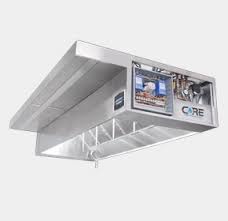In the dynamic and bustling realm of the culinary industry, a well-designed restaurant exhaust system stands as a silent yet crucial force. Beyond its functional role, this system plays a pivotal role in ensuring a safe, comfortable, and productive environment for both kitchen staff and patrons. From expelling cooking odors to managing heat and maintaining air quality, the restaurant exhaust system is a complex orchestration of components and considerations. In this comprehensive guide, we delve into the intricacies of designing a restaurant exhaust system, exploring key factors, components, and best practices that contribute to its efficiency and effectiveness.
-
Understanding the Basics of Restaurant Exhaust Systems:
A restaurant exhaust system is a ventilation setup designed to remove airborne contaminants, heat, and cooking byproducts from the kitchen area. It typically comprises a range hood, ductwork, exhaust fans, and filtration components. The primary objective is to enhance air quality, prevent the accumulation of harmful particles, and create a comfortable environment for both kitchen staff and diners.
-
Assessing Kitchen Layout and Size:
The foundation of an effective exhaust system design begins with a thorough assessment of the kitchen's layout and size. Different kitchen setups, whether open-concept or traditional, require tailored approaches to ensure optimal air circulation and removal of contaminants. By considering the location of cooking appliances, workstations, and seating areas, designers can determine the most suitable placement for exhaust hoods and ductwork.
-
Determining Ventilation Requirements:
Accurate calculation of ventilation requirements is essential to ensure that the exhaust system meets the demands of the kitchen's activities. Factors such as cooking equipment types, heat output, and anticipated cooking load influence the volume of air that needs to be ventilated. Proper ventilation rates contribute to effective odor control, temperature management, and a reduction in potential fire hazards.
-
Selecting Appropriate Exhaust Hood Types:
Different cooking processes generate varying levels of heat, smoke, and contaminants. Selecting the appropriate exhaust hood type is critical to capturing and containing these byproducts effectively. Common hood types include canopy hoods, proximity hoods, and island hoods, each designed to address specific cooking scenarios and equipment.
-
Ductwork Design and Configuration:
The design and configuration of the ductwork are integral components of an exhaust system's functionality. Properly sized and routed ductwork ensures efficient air movement, minimizing resistance and optimizing airflow. It's essential to consider factors such as duct material, insulation, and the avoidance of sharp bends that could impede airflow.
-
Filtration and Air Cleaning:
Filtration and air cleaning mechanisms play a vital role in enhancing air quality by removing grease, particles, and odors. Baffle filters, mesh filters, and charcoal filters are commonly employed to capture grease particles and neutralize cooking odors. The selection of appropriate filters and their regular maintenance are essential for consistent performance.
-
Integration of Exhaust Fans:
Exhaust fans are the workhorses of the system, facilitating the movement of air through the ductwork and out of the building. The size and capacity of exhaust fans should align with the ventilation requirements of the kitchen. Proper placement of fans and the incorporation of variable speed controls allow for adjustments based on cooking intensity and load.
-
Fire Suppression and Safety Measures:
Given the potential fire hazards associated with commercial kitchens, fire suppression systems are a critical component of restaurant exhaust systems. Automatic fire suppression systems, interlocked with the exhaust system, provide rapid response in the event of a fire. Additionally, ensuring that the exhaust system meets local fire safety codes and regulations is paramount.
-
Balancing Makeup Air:
As air is removed from the kitchen through the exhaust system, a balanced influx of makeup air is essential to maintain air pressure and prevent issues like backdraft. Makeup air units are designed to introduce fresh, tempered air into the kitchen space, contributing to a comfortable environment and efficient exhaust operation.
-
Regular Maintenance and Inspections:
The longevity and efficiency of a restaurant hood systems hinge on regular maintenance and inspections. Scheduled cleaning of filters, ductwork, and hoods prevents the buildup of grease and contaminants that can compromise airflow and air quality. Routine inspections also help identify potential issues early, minimizing disruptions and ensuring continuous functionality.
Conclusion
Designing a restaurant exhaust system is a multifaceted endeavor that demands careful consideration of various factors, from kitchen layout to ventilation requirements and safety measures. The successful design and implementation of an exhaust system contribute not only to a safer and more comfortable kitchen environment but also to the overall dining experience for patrons. As culinary spaces continue to evolve and innovate, a well-designed exhaust system stands as an essential component, working tirelessly behind the scenes to ensure the smooth operation of the kitchen and the creation of exceptional culinary delights.


No comments yet